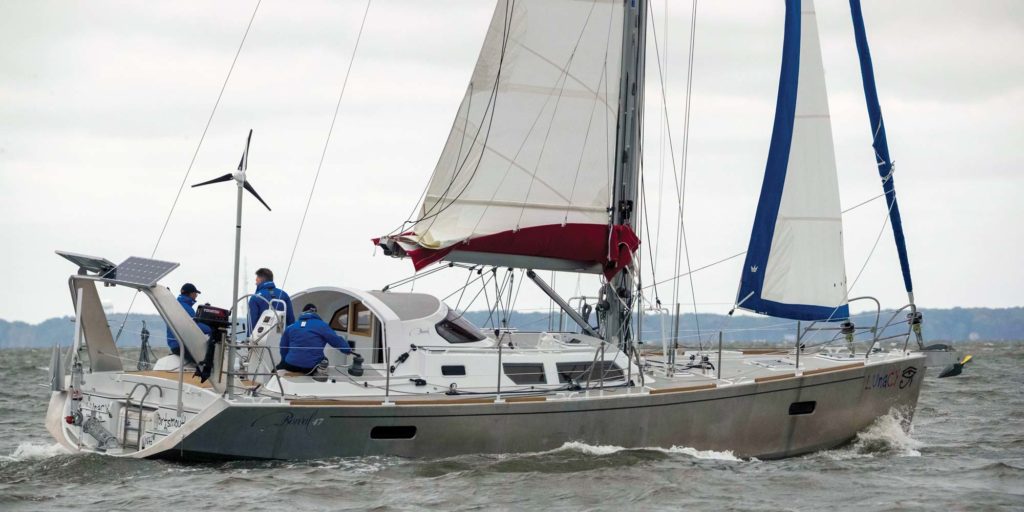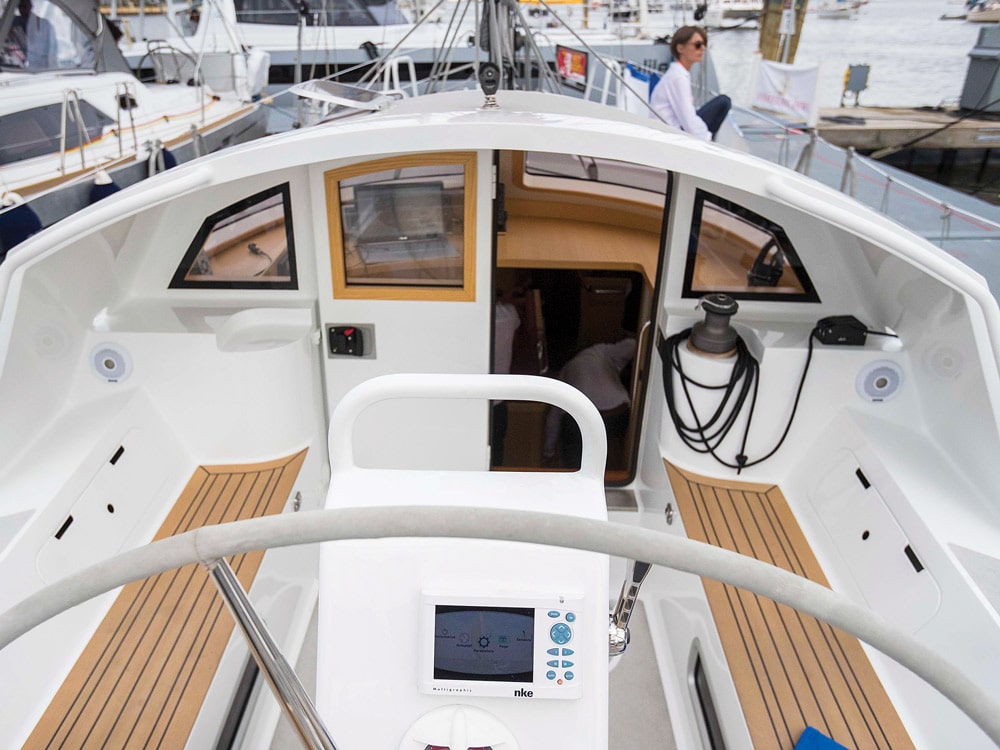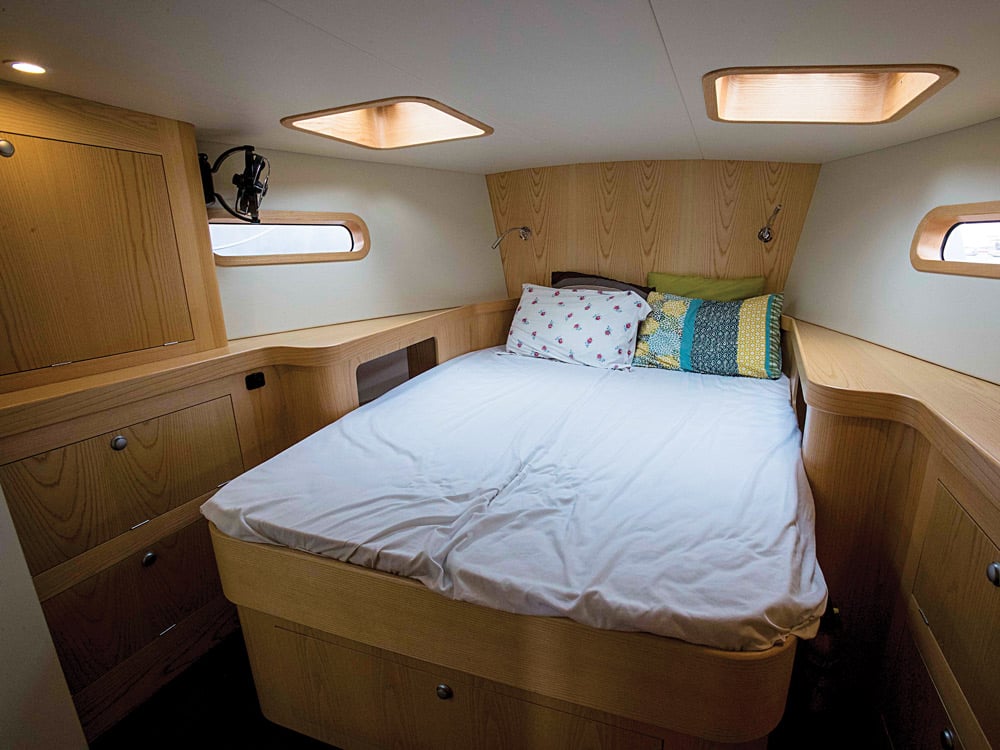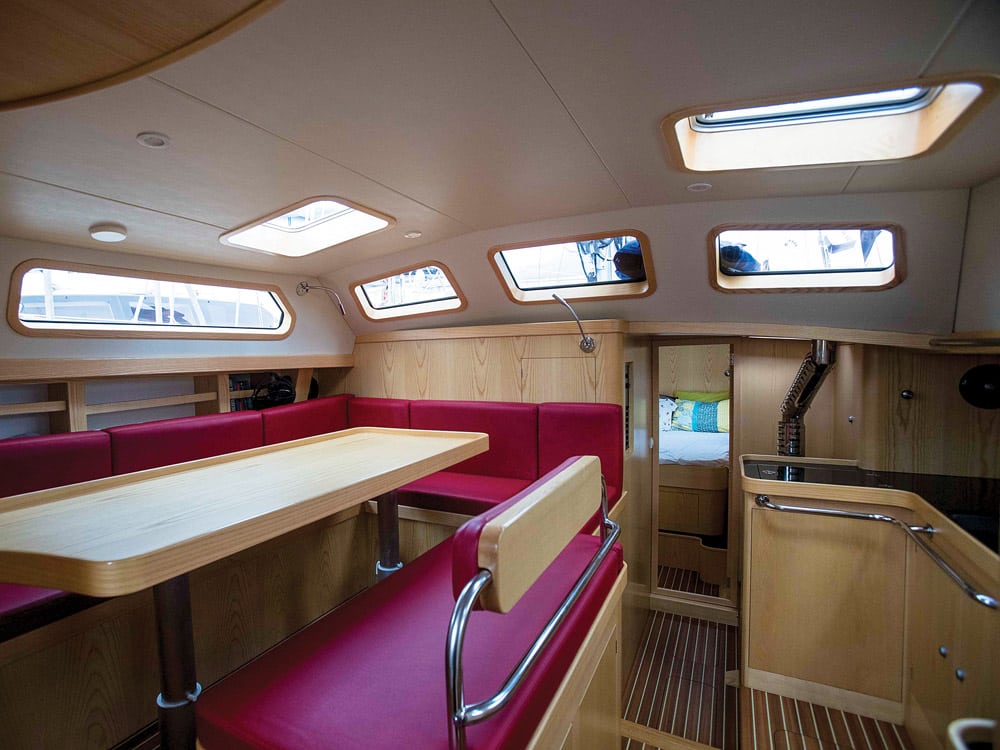
Gale-force winds blew through the mid-Atlantic region on the night before we were scheduled to sail the Boréal 47 on Chesapeake Bay last October. First thing that morning, we called the builder to cancel.
“Why don’t we keep our appointment?” replied Jean-François Eeman, Boréal’s managing director. “These are the conditions she was built for.”
So Cruising World’s Boat of the Year judges suited up and went for a sail that I suspect none of us will ever forget. It all crystalized for us as we sailed out from behind Greenbury Point into the full teeth and boisterous seaway of a northerly that by now had diminished into the high 20s.
“Go ahead and take your hand off the wheel,” Eeman suggested to my colleague Bill Bolin, which he very tentatively did. No autopilot was engaged; no windvane; no lines from the sheets. “It’s OK,” said Eeman. “Just let her go.” Sure enough, with mainsail reefed and the genoa partially furled, the Boréal steered itself for a minute, two minutes, five minutes, six. And even as we walked around the deck and moved our weight around the boat, I’m convinced it would have continued on like that, elegantly balanced and steering true, all the way to Norfolk if we hadn’t made other appointments for that day.
The secret to the boat’s impeccably balanced steering — just one of this boat’s several secret weapons — is a pair of shallow daggerboards mounted aft athwart the single midship rudder. By raising the windward dagger and lowering the leeward, the boat tracks as sweet as you please. For context, it’s worth mentioning that twin rudders have become a full-blown trend in this year’s fleet of cruising boats. But the Boréal’s creator, Jean-François Delvoye, distrusts twin rudders. (In a company led by two men named Jean-François, the principals answer to JFE and JFD.)

Here is a cockpit that any long-range sailor will appreciate. The hard dodger provides shelter for two when tucked underneath it. Pop through the watertight door into an enclosed pilothouse when conditions worsen. Jon Whittle
Delvoye had conceived and designed the Boréal two decades ago, during a six-year circumnavigation with his wife and four children that included long stretches of time in Patagonia. His firsthand experience taught him to distrust twin rudders because their position outboard of the keel leaves them too exposed. Yet so many of today’s full hull forms, with the beam carried well aft, often beg for some steering help once the boat is heeled. The Boréal’s daggers do exactly that, and all while keeping the rudder protected.
That brings us to another of the Boréal’s secret weapons: its keel box — or, as Delvoye calls it, the “keel embryo.” The boat’s centerboard, which drops down to 8 feet 1 inch, is a NACA foil that’s designed for lateral stability only, not ballast. The keel embryo contains the boat’s lead ballast and extends deeper than the rudder’s lowest point. What’s more, the Boréal is designed to sit on its keel embryo when the tide runs out from beneath it.
“In Brittany,” said Eeman of the region of France that’s home to the Boréal yard, “we have 10 meters [33 feet] of tide. We use the boat as a weekend house on the beach.” No poles, no crutches: The boat sits on its own bottom. “We can stand on the side and jump. The boat will not flip over. If you had a virtual finger, you could push the mast, and up to 14 degrees she’ll come back. At 14 degrees, she would slowly lay over on her first chine, which is at the same angle. So you never fall.”

Boréal builds between eight and 10 boats per year. Since 2005, the yard has launched roughly 50 boats in two sizes: 44/47 and 52/55. Classic transom versus scoop transom accounts for the difference around the slashes. We sailed hull number 37, Lunacy, owned by sailing journalist Charlie Doane. For details about Doane’s firsthand experience with the boat, including beaching and a shakedown transatlantic passage, check out “Lunacy Report” at wavetrain.net.
The Boréal’s standout design feature is its well-executed doghouse and pilothouse. This is essentially a hard dodger that provides outside shelter for two at the forward end of the cockpit. A massive watertight door opens into a pilothouse with a portside nav station inside the heated cabin and still at cockpit level. From that pilothouse, you step down the companionway into the saloon and private cabins.
The Boréal’s construction is robust aluminum built to an “expedition boat” standard, following from the experience both Delvoye and Eeman gained from sailing in high latitudes, including Antarctica. Of course, every building material comes with its particular concerns. While stronger and far more abrasion-resistant than fiberglass-reinforced plastic, aluminum lives near the least noble end of the galvanic series of metals. To counteract corrosion, Boréal sandblasts the hull below the waterline, then applies an epoxy barrier coat within eight hours, before oxidation can start. From there, the underwater corrosion-mitigation strategy continues with three sacrificial anodes: one at the rudder, one at the centerboard and a large 5-kilogram anode bolted to the hull near the engine and stainless-steel propeller shaft. Custom-made plastic and anodized bushings isolate dissimilar metals throughout the boat. A hull-potential meter at the pilothouse keeps the operator apprised of any galvanic-corrosion issues before they damage material.

The layout of the 2018 Boat of the Year winner is clean and cozy. Jon Whittle
In the 2018 fleet, this Boréal 47 won Cruising World’s award as overall Boat of the Year. It’s a boat that puts me in mind of something the legendary yacht designer Bill Crealock said at a design forum organized around the magazine’s 25th anniversary (see “The Futurists,” CW, October 1999): “The challenge of cruising boats,” he said, “is that they’re a fixed platform operating in a variable environment. You really need one boat for passagemaking and another one for port.” Our 1999 designers forum ended with a prediction: “The trend of future boats will see an increase in their adaptability to all the contradictory situations we sailors love to put them in.”
The Boréal’s ultimate secret weapon is its overall design and build. Robust, seakindly, balanced, beachable: It embodies Crealock’s long-ago dream for the future.
Tim Murphy is a CW editor at large and a longtime Boat of the Year judge.
Boréal 47 Specifications
| LENGTH OVERALL | 45’3” (14.55 m) |
| WATERLINE LENGTH | 41’1” (11.63 m) |
| BEAM | 14’1” (4.3 m) |
| DRAFT | 3’3”/8’1” (1.02 m/2.48) |
| SAIL AREA (100%) | 1,067 sq. ft. (105 sq. m) |
| BALLAST | 8,378 lb. (3,800 kg) |
| DISPLACEMENT | 25,000 lb. (11,339 kg) |
| BALLAST/DISPLACEMENT | .33 |
| DISPLACEMENT/LENGTH | 193 |
| SAIL AREA/DISPLACEMENT | 17.7 |
| WATER | 200 gal. (760 l) |
| FUEL | 158 gal. (600 l) |
| HOLDING | 16 gal. (63 l) |
| MAST HEIGHT | 60’5” (18.4 m) | |
| ENGINE | Volvo Penta D2-55 CV or Nanni N4.60 |
| DESIGNER | Jean-François Delvoye |
| PRICE | $650,000 |
Boréal SARL (Minihy-Tréguier, France)
+33 2 96 92 44 37
boreal-yachts.com
Sea Trial
| Wind speed | 16 to 22 knots |
| Sea State | 2 to 3 feet |
| Sailing | Closehauled 7.2 knots, Reaching 8.5 knots |
| Motoring | Cruise (1,800 rpm) 6 knots, Fast (2,400 rpm) 7.4 knots |








